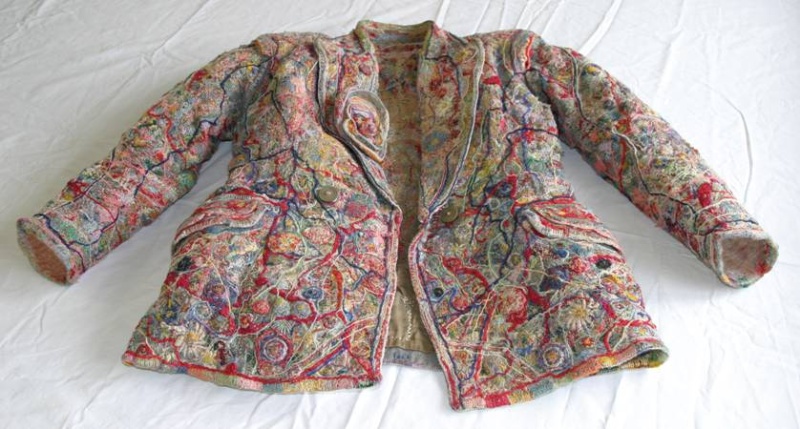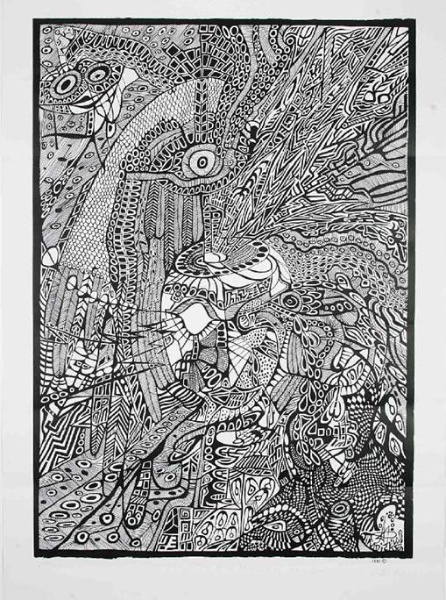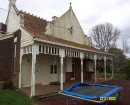CUNNINGHAM DAX COLLECTION
KENNETH MYER BUILDING, THE UNIVERSITY OF MELBOURNE, 30 ROYAL PARADE PARKVILLE, MELBOURNE CITY
-
Add to tour
You must log in to do that.
-
Share
-
Shortlist place
You must log in to do that.
- Download report



Statement of Significance
-
-
CUNNINGHAM DAX COLLECTION - History
The history of the Collection is closely intertwined with the history of mental health services in Victoria over a period of sixty years. Most significantly it represents a lasting legacy to its founder, Dr. Eric Cunningham Dax who initiated a series of important reforms to mental health services in Victoria during his tenure as Chairman of the Mental Health Authority from 1952 until 1969. Dr Dax's reforms included dividing the care of people with intellectual disabilities from those who were mentally ill, initiating child psychiatric services psychogeriatric services, forensic psychiatric services and services for people with alcohol dependency. He was also closely involved in setting up Australia's first telephone counselling service. While Cunningham Dax introduced modern treatments, including the use of antipsychotic and antidepressant medications and general anaesthesia for electroconvulsive therapy (ECT), he was best known for his pioneering work in community treatment and the moving of psychiatric treatment from asylums to community settings. By the end of his professional life Dax had attained international recognition for his ideas about the humane treatment and care of people in public mental institutions and about the support needed to enable them to live more independent lives in the community.
Dax was also among the first to appreciate the detrimental effects of stigma attached to mental illness which he felt was the result of fear and ignorance. As such, he felt strongly that mental health care required the support of the general community and found that the artworks of his patients could offer a most interesting and accessible form of public education about mental health. It provided a way of presenting a more sympathetic, less paternalistic face to the public, and thus had political implications for the way in which people with mental illness were perceived and treated by the state. In this regard the Collection reminds contemporary audiences of relatively recent changes in psychiatric care, which have seen a shift from custodial care (incarceration in asylums) to deinstitutionalisation and community-based treatment programs.
Dax was among the first to bring occupational therapy into mental health in Victoria, introducing art and music programs for patients and bringing in artists and musicians to restore humanity to those archaic institutions. Dax's pioneering work in this regard laid foundations for the study of creativity and mental illness and was a precursor to present day art therapy programs. Institutionalised patients were encouraged to draw and paint freely, without instructions, in order to help their psychiatrists understand their subjective experience of their mental illness. Consequently the works had the status of medical records and were kept with the patients' written records. Provenance, in the form of the creator's name and the date and place of making is known for approximately ninety percent of the works dated to this period. Written records also exist about some artists which provide further contextual information about these works.
The Collection is of historic value on a number of levels, but perhaps most fundamentally as a record of the lived experiences of mental hospital patients in Victoria from the 1950s to the 1960s. As such, the art works offer a unique opportunity to learn about the lives of patients in these institutions of a previous era which are otherwise contained in patient records which inevitably reflect clinicians' perspectives rather than those of the patients.
Dax's chairmanship of the Mental Hygiene Authority ended in 1969 following an invitation from the Tasmanian government to assist in developing community mental health and welfare. Dax relocated to Hobart where he was based for a little over a decade. During this time Dax was informed that the art works stored in the asylums across Victoria were in danger of being discarded. He ensured this did not eventuate and after returning to Melbourne in the 1980s, Dax devoted much time to cataloguing the works he had taken into his care during his retirement. Dax saw the collection as having huge educational potential and was determined to preserve the works for the education of those charged with caring for patients with mental illness and of the community more broadly.
Since the early 1980s the collection has continued to grow. Works have been donated by patients, former patients and their families. Collecting has also broadened to include works sourced from diverse groups whose members have either experienced the trauma of child sexual abuse, the holocaust, war or migration, or have been affected by conditions such as autism or Alzheimer's disease. These works have been produced outside the asylum system under very different conditions and circumstances to those collected in the 1960s and 70s.
The Collection was formerly established at the University of Melbourne in 1985 but has since relocated and currently operates under the auspices of The Mental Health Research Institute of Victoria. Over the past five years The Collection's expansion has been matched by an extended range of programs to increase its visibility and use. This has occurred within the expressed aims of The Collection to 'promote widely a greater understanding of people who experience mental illness and/or psychological trauma, and to foster an appreciation of their creativity through the preservation and ethical presentation of their original works.'
CUNNINGHAM DAX COLLECTION - Assessment Against Criteria
h. Special association with the life or works of a person, or group of persons, of
importance in Victoria's history.
The history of the Cunningham Dax Collection is associated with the professional life of psychiatrist Dr. Eric Cunningham Dax and the history of mental health services in Victoria during the mid twentieth century. Dr Dax initiated a series of important reforms to mental health services in Victoria during his tenure as Chairman of the Mental Health Authority from 1952 until 1969. One of Dax's reforms was the introduction of art therapy to the mental health institutions of Victoria. The collection of art works known as the Cunningham Dax Collection is a legacy of Dax's pioneering work in reforming mental health care in Victoria.
The Collection consists of art works made in a diverse range of media including 47 textile objects, 179 ceramics, 33 collages, 95 paintings on canvas, 110 paintings on board/masonite, 11,000 works on paper, 30 photographs and other archival material.
CUNNINGHAM DAX COLLECTION - Plaque Citation
CUNNINGHAM DAX COLLECTION
Works created by psychiatric patients were collected initially by Dr Eric Cunningham Dax, Victorian Chairman of Mental Health from 1952 to 1969 who introduced art therapy and other reforms to the Victorian mental health systemCUNNINGHAM DAX COLLECTION - Permit Exemptions
General Exemptions:General exemptions apply to all places and objects included in the Victorian Heritage Register (VHR). General exemptions have been designed to allow everyday activities, maintenance and changes to your property, which don’t harm its cultural heritage significance, to proceed without the need to obtain approvals under the Heritage Act 2017.Places of worship: In some circumstances, you can alter a place of worship to accommodate religious practices without a permit, but you must notify the Executive Director of Heritage Victoria before you start the works or activities at least 20 business days before the works or activities are to commence.Subdivision/consolidation: Permit exemptions exist for some subdivisions and consolidations. If the subdivision or consolidation is in accordance with a planning permit granted under Part 4 of the Planning and Environment Act 1987 and the application for the planning permit was referred to the Executive Director of Heritage Victoria as a determining referral authority, a permit is not required.Specific exemptions may also apply to your registered place or object. If applicable, these are listed below. Specific exemptions are tailored to the conservation and management needs of an individual registered place or object and set out works and activities that are exempt from the requirements of a permit. Specific exemptions prevail if they conflict with general exemptions. Find out more about heritage permit exemptions here.Specific Exemptions:General Conditions: 1. All exempted alterations are to be planned and carried out in a manner which prevents damage to the fabric of the registered place or object. General Conditions: 2. Should it become apparent during further inspection or the carrying out of works that original or previously hidden or inaccessible details of the place or object are revealed which relate to the significance of the place or object, then the exemption covering such works shall cease and Heritage Victoria shall be notified as soon as possible.STANDARD EXEMPTION - MOVEMENT OR RELOCATION
The temporary relocation, movement or external loan of a registered heritage object does not require permit approval by the Executive Director pursuant to the Heritage Act 1995 where the activity is performed in accordance with the accepted standards, policies and procedures of the organisation concerned.
STANDARD EXEMPTION - CONSERVATION
The conservation, research or analysis of a registered heritage object does not require approval by the Executive Director pursuant to the Heritage Act 1995, where the activity is performed in accordance with the accepted standards, policies and procedures of the organisation concerned.
CUNNINGHAM DAX COLLECTION - Permit Exemption Policy
Permit Policy
The cultural significance of the Cunningham Dax Collection lies in it being a unique collection of objects (art works) produced by the mentally ill patients who were institutionalised in Victoria during the 1950s and 1960s. The cultural value of the works is embedded in their being an intact collection and for their association with the long professional life of Dr Eric Cunningham Dax. The permit policy requires that the objects in this collection be housed and preserved so as to maintain their cultural heritage significance. Permit exemptions will usually be granted for movement, relocation, loan and conservation activities, as specified below.
The Executive Director, Heritage Victoria acknowledges that the Cunningham Dax Collection may seek to accession more objects to the collection in the future. For the purposes of this registration event the registration shall include all objects listed in the catalogue of works held by the custodians of the Cunningham Dax Collection up to and including the date of 1 October, 2008. Further objects may be added to this registration by applying to the Executive Director Heritage Victoria for an amendment to the existing registration
-
-
-
-
-
FORMER CARLTON AND UNITED BREWERY
 Victorian Heritage Register H0024
Victorian Heritage Register H0024 -
LOTHIAN BUILDINGS
 Victorian Heritage Register H0372
Victorian Heritage Register H0372 -
SHOPS AND RESIDENCES
 Victorian Heritage Register H0043
Victorian Heritage Register H0043
-
1 Jackson Street
 Yarra City
Yarra City -
1 Lightfoot Street
 Yarra City
Yarra City -
1 Longfield Street
 Yarra City
Yarra City
-
-












